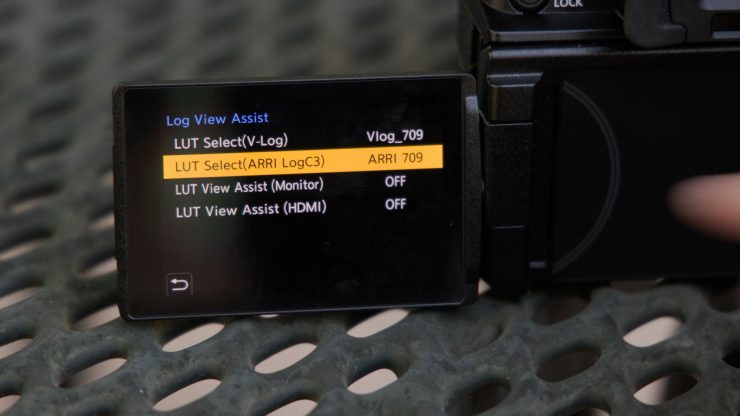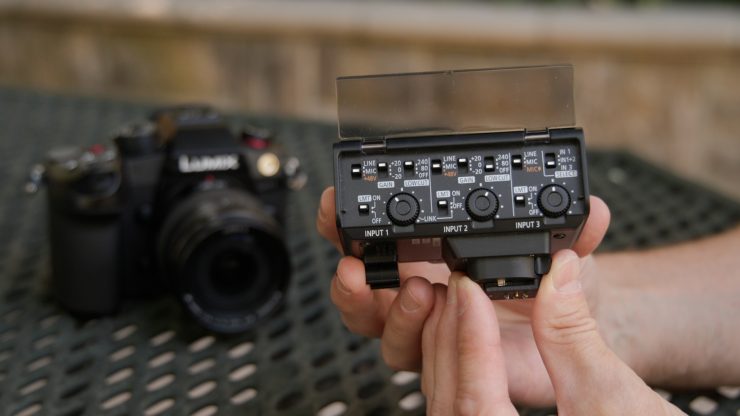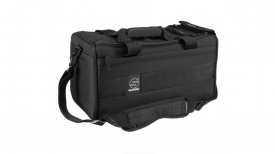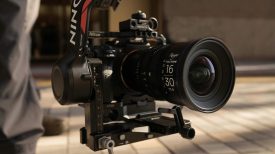Panasonic has announced the GH7, its latest Micro Four Thirds camera. The Lumix GH7 features internal ProRes RAW recording, 32-Bit float audio recording with the optional DMW-XLR2 audio interface, phase hybrid autofocus, active internal stabilization, and the ability to use ARRI’s LogC3, all jammed into a compact body.
Key features
- 25.2MP BSI CMOS Micro Four Thirds Sensor
- 4K60 4:2:2 10-Bit Unlimited Recording
- 5.7K60, 4K120 HFR, FHD 240p VFR
- ProRes RAW, 32-Bit Float, 13+ Stop WDR
- Dual I.S. 7.5-Stop 5-Axis Stabilizer
- 3.68m-Dot OLED Electronic Viewfinder
- 3.0″ 1.84m-Dot Free Angle Touchscreen
- CFexpress Type B & SD UHS-II Card Slots
The Micro Four Thirds Lumix GH7 Mirrorless also features Adobe Cloud Frame.io compatibility, Open Gate recording, and real-time custom LUTs.
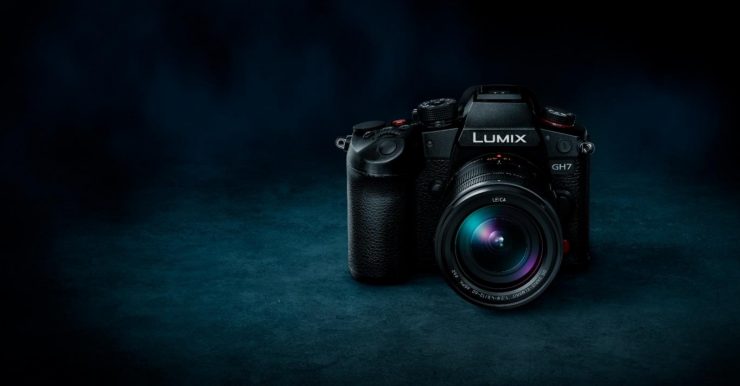
This update to the GH6 features a 25.2MP sensor, 5.7K up to 30p, Apple ProRes 422 HQ and ProRes 422 internal recording, improved AF performance, 13+ stops of dynamic range, and 5-axis stabilization.
Key GH7 Updates
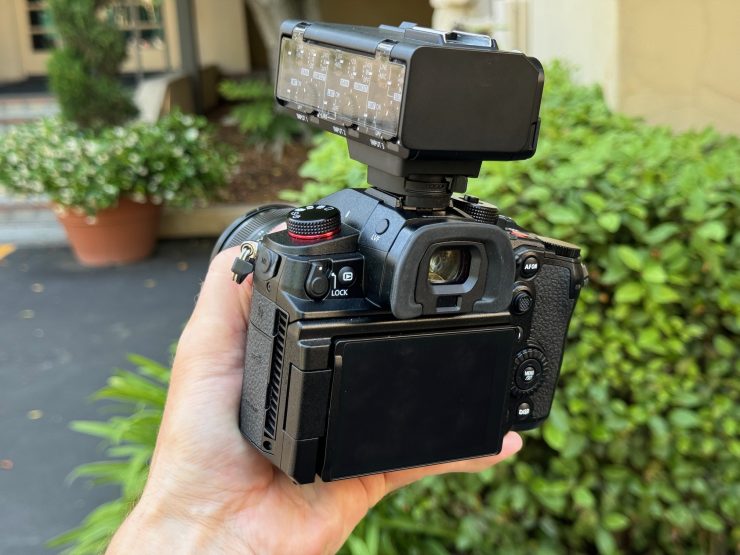
- Newly equipped with Apple ProRes RAW internal recording and 32-bit float recording
- 25.2MP BSI CMOS sensor with 13+ stop dynamic range boost with rich gradation for vibrant, detailed photos and videos
- There’s no longer a need to adjust audio recording levels during shooting – with 32-bit float recording using the optional DMW-XLR2 adapter and
- Internal recording of 5.7K 30p Apple ProRes 422 HQ and Apple ProRes RAW HQ
- Upload still images and proxy videos directly to the Adobe Cloud Frame.io platform.
- One shot for all social media platforms in all aspect ratios via Open Gate
- Improved AF performance with Phase Detection Autofocus by adding real-time recognition
- AF for Human/Animal/Car/Motorcycle/Train/Airplane
- Real-time custom LUTs to apply new color expressions
ARRI LogC3
Via a paid ($200 USD) Software Upgrade Key DMW-SFU3A on the LUMIX GH7. With this upgrade you can utilize ARRI’s LogC3 which according to Panasonic, enables you to seamlessly color match the GH7 with ARRI’s digital cinema cameras. Panasonic has licensed LogC3 from ARRI.
The image processing of the ARRI LogC3 curve on LUMIX GH7 has been certified by ARRI for the implementation of this function. This option to use ARRI LogC3 is only available when you are shooting in the ProRes 422, ProRes 422 HQ and ALL-Intra codecs. You can’t use ARRI LogC3 when recording in ProRes RAW, that can only be done in V-Log.
Now, while you will be able to get a pretty good match between ARRI cameras and the GH7, because the GH7 doesn’t have the same amount of dynamic range, it will clip highlights before you reach the limit of the LogC3 curve. The base ISO when shooting in ARRI LogC3 is 320, as opposed to 500 ISO when shooting V-Log. This is because the LogC3 curve was designed to be used with cameras that have a higher dynamic range. You will not want to underexpose your image when shooting in ARRI LogC3 on the GH7, as you will introduce a lot of noise.
Video data shot with LUMIX GH7 in ARRI LogC3 can easily be converted to your favorite look. The ARRI Look Library contains 87 high-quality ARRI Looks to choose from. It is also possible to store the LUT package for 709 conversion (ARRI Look Library LogC3 to Rec709 3D-LUTs) in the LUT Library of the LUMIX GH7, and combine it with the REAL TIME LUT function to capture videos with ARRI LUTs straight out of the camera.
Using the ARRI Look Library (log-to-log), you can color grade videos recorded with ARRI LogC3 and apply the desired ARRI Look within the log space. Additionally, by using the LUT package (ARRI_LogC3_v12_LUT_Package) you can convert the color space of various display devices, allowing you to output the ARRI Look according to the desired color space in SDR and HDR.
Shooting in ARRI LogC3 on the LUMIX GH7 looks to be a good solution if you want a small sized B-cam, C-cam, etc. that can match larger ARRI cameras.
Now, Panasonic did tell me that they believed that the natural progression from a camera like the GH5 was to something like an ARRI, but I don’t personally believe that is true. The jump from a mirrorless hybrid is usually to an affordable sub $10,000 USD digital cinema camera. Usually people who start off with a mirrorless hybrid move up to a smaller sized affordable digital cinema camera, but the problem is Panasonic no longer has a cine division so there is no where for them to go. This is the biggest issue Panasonic faces, as unlike the majority of their competitors, they don’t have cine products anymore.
In addition, ARRI LogC3 recording can also be used on the LUMIX GH6 in the same way as the LUMIX GH7 by using the Software Upgrade Key DMW-SFU3A, with the exemption of the REAL TIME LUT function which is not available on this model.
32-Bit Float Recording
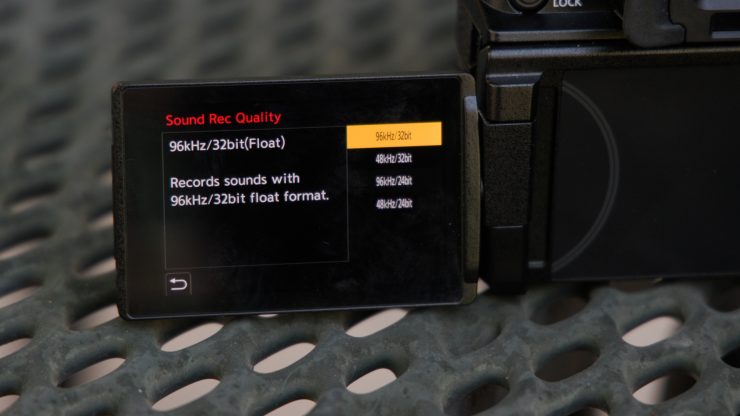
The GH7 is the World’s first mirrorless hybrid that is capable of recording 32-bit float internally.
This can only be done if you use the optional Panasonic DMW-XLR2 XLR Microphone Adapter ($497.99 USD).
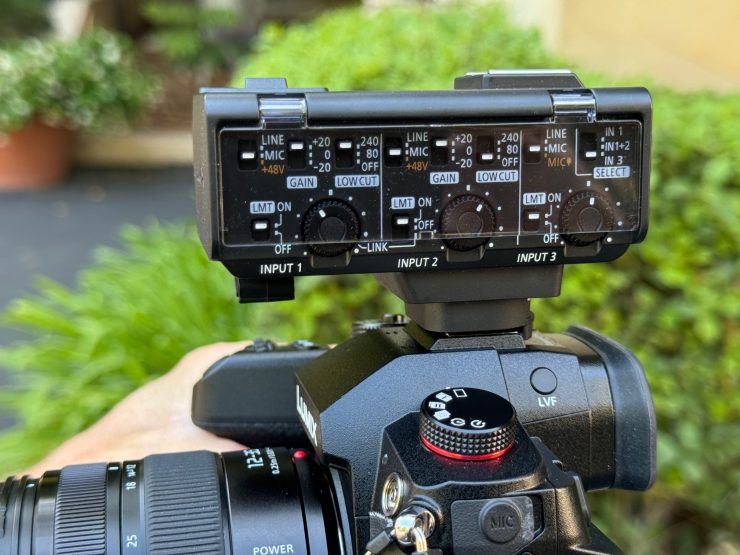
For recording interviews with multiple mics, HDMI will output 4-channels of audio data.
Sensor
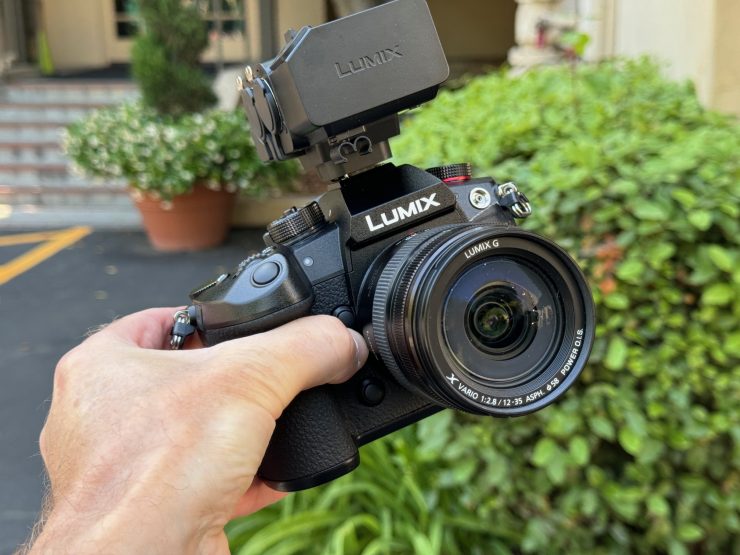
The new 25.2MP BSI CMOS sensor was redesigned from the ground up. Panasonic claims that this new this sensor improves upon its predecessors in the GH Series with new silicone and software. It has an improved 13+ stops of dynamic range. For maximum sharpness, the sensor is unhindered by a low-pass filter; it is claimed to smooth out any moiré through intelligent detail processing from its updated Venus engine.
The Venus Engine has twice the power of previous generations, which enables 75 fps burst shooting or up to 240 fps variable frame rate (VFR) slow motion video footage. The Venus Engine’s fast sensor readout limits the rolling shutter distortion.
Video Recording
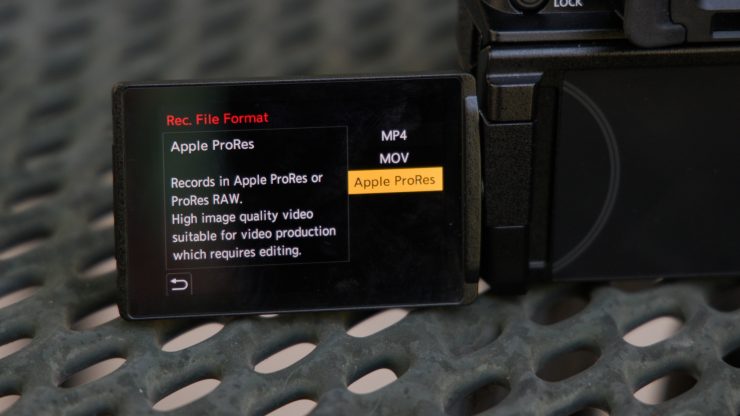
You can use a CFexpress Type B card to internally record 5.7K Apple ProRes 422 HQ and ProRes RAW HQ, or the SD slot can capture up to 10-bit 4K120p footage. It still has the ability to record high bitrates and unlimited recording times regardless of the codec, resolution, or frame rate. This unlimited video recording is made possible with efficient heat dissipation processing and the integration of a cooling fan.
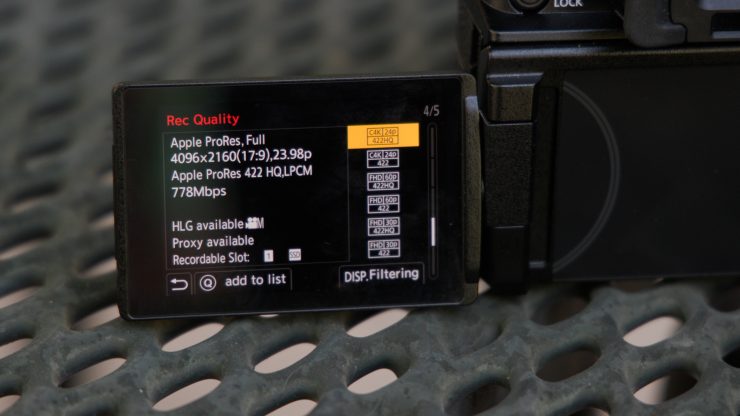
5.7K up to 30p recording is supported in Apple ProRes 422 HQ/ProRes 422 and ProRes RAW codecs. ProRes 422 HQ/ProRes 422 is also supported in DCI 4K and FHD at up to 60p.
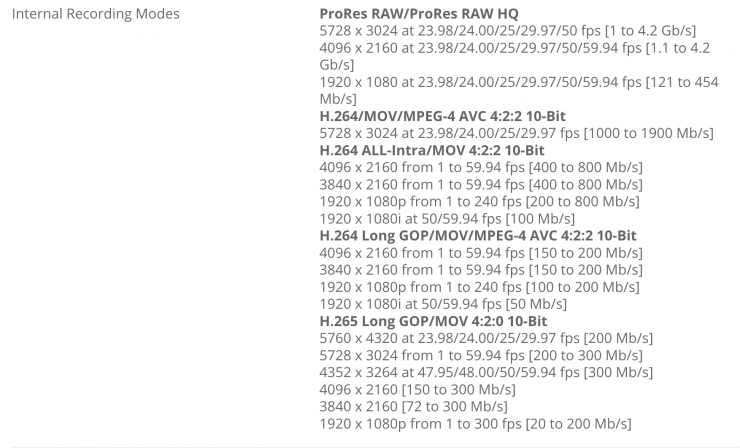
The GH7 supports unlimited recording up to DCI 4K at 60p with 4:2:2 10-bit sampling. Shooting in V-Log and V-Gamut will give you 12+ stops of dynamic range, which can be increased to 13+ stops by activating its dual-analog gain circuits with Dynamic Range Boost Mode. One circuit using ISO 800 absorbs the richness of the visible spectrum while maintaining detail in the highlights, and ISO 2000 captures low-noise gradients of black in the shadows. The picture is composited once passing through the Image Synthesis Dedicated Circuit. This makes it different from a dual-native design because you’re not selecting one ISO or the other, but both are working in tandem. Dynamic Range Boost Mode is available for footage shot up to 60 fps.
Intelligent Image Processing 3D noise reduction is achieved by comparing three sequential frames, then automatically scrubbing the noise which appears in only one of the three frames. Intelligent detail processing eliminates the need for a low-pass filter and smooths fine details like hair and wires to minimize moiré patterns.
The GH7 supports both .CUBE and .VLT formats for V-Log View Assist in real time to approximate the final look of your deliverable.

In addition to internal recording to the CFexpress card, the GH7 supports 12-bit raw video output in 5.7K, DCI 4K, and Anamorphic 5.8K and 4.4K formats via HDMI when recording to Atomos Ninja V and V+ external recorders in ProRes RAW.
You can record open gate with the 4:3 sensor for 5.8K 30p 4:2:0 10-bit and 4.4K 60p 4:2:0 10-bit video. There is also the ability to store up to 10 anamorphic lenses on the GH7. Images can be desqueezed and the you can select from 1.30x, 1.33x, 1.5x, 1.8x, or 2.0x.
The Image Stabilizer Anamorphic setting is ideal for using an anamorphic lens. To properly interpret the visual information for stabilization processing, you need to select from 1.30x, 1.33x, 1.5x, 1.8x or 2.0x depending on the lens magnification.
By shooting in high frame rate (HFR) 4K you can boost your frame rate to 120p, or in Full HD 1080p you can do up to 240p. Autofocus remains available to actively make changes while recording up to 200 fps.
Simultaneous internal and external recording via the HDMI is also possible. Record in resolutions up to DCI 4K in 17:9 with a bit depth up to 4:2:2, 10-bit, and frame rates up to 60p, 50p, 30p, 25p, 24p.
The dual card slot provides options dependent on the bitrate of your shoot. The CFexpress Type B slot is necessary to record higher bitrate formats like Apple ProRes RAW and 422 HQ and 800 Mb/s 4:2:2 10-bit ALL-Intra footage. The SD card slot records bitrates up to 600 Mb/s when using high performance UHS-II U3 Class 10 SD cards.SSD Recording Over USBBoth video and stills can be recorded and played back using an external SSD when connected via the USB-C port. This enables saving to larger capacity drives and working with media that’s immediately compatible with most post-production workflows
IBIS
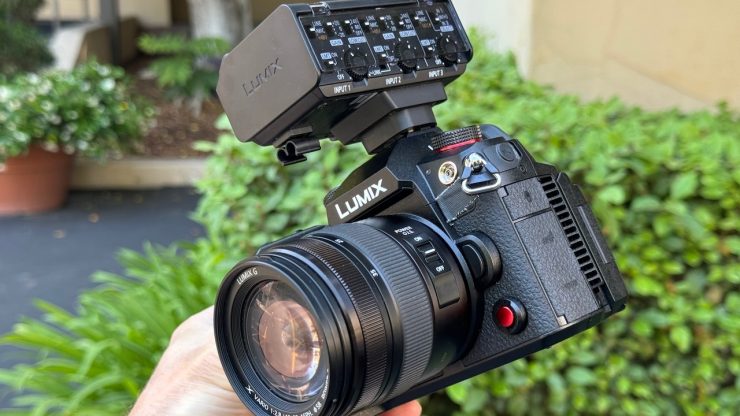
In-body, sensor-shift, 5-axis image stabilization is obtained with a high-precision gyro-sensor and a stabilization algorithm. At all focal lengths, this stabilization technology offers 7.5 stops of deviance from the shutter speed dictated by the reciprocal rule. Sensor-shift technology works with the optical image stabilization of Panasonic lenses. Electronic stabilization is available who those who accept the slight cropping effect it requires. Boost I.S. mode is the most extreme form of electronic stabilization, simulating a shot locked off on a tripod.AF & AE Highlights
AF
The processing speed of the autofocus has been tripled, powering the 315-area contrast-detection depth-from-defocus (DFD) system. The updated algorithm calculates the distance to your subject and predicts whether it is moving closer or further away from the camera, anticipating where it will be for the following frame. It functions by collecting data from several focal planes, then creating a 3D, real-time depth map.
The subject-tracking focusing system also supports face, eye, head, body, and animal recognition. The autofocus will automatically switch from body recognition to face, then eye recognition as the subject approaches the camera for improved sharpness.
The Focus Limiter, Manual Focus Assist, and an updated joystick enable quick and precise focusing. Zone AF is a less obstructive overlay, and Face Priority in Multi Metering prevents unwanted exposure changes.
Stills
The GH7 is capable of recording 100MP stills with a wide dynamic range, 7.5 stops of dual image stabilization, and continuous shooting up to 75 fps with an electronic shutter.
Image stabilization technology enables 8 consecutive stills to be synthesized into one high-resolution, 100MP image without the use of a tripod. Dynamic Range Boost Mode is automatically engaged in all photo modes.Clean Details in Low LightDetails are retained and color noise is reduced, even when shooting in dimly lit conditions that require high ISO. When conditions are less than ideal, 2D noise reduction gives your photos a more natural and three-dimensional quality.
You can manually select between several shutter modes depending on your needs: a mechanical shutter type, electronic front curtain type, electronic shutter type, electronic shutter type with noise reduction after shooting at a slow shutter speed, or let the camera automatically switch the shutter type depending on the conditions and shutter speed.
You can achieve 75 fps burst shooting (AFS, electronic shutter) while maintaining 25.2MP due to the fast readout speed of the GH7 sensor and the superior processing power of the new Venus Engine. The high sensor readout speed reduces rolling shutter distortion. Shoot 75 fps with an electronic shutter and AFS or 14 fps with a mechanical shutter and AFS. With AFC, you can shoot at up to 8 fps with a mechanical shutter or 7 fps with an electronic shutter.
Streaming Capabilities
The GH7 can stream directly via Wi-Fi, USB tethering, or wired Ethernet LAN. It supports:
- up to 1920 x 1080p59.94 via Wi-Fi via RTMP / RTMPS
- up to UHD 4K29.97 / 1920 x 1080p59.94 via USB tethering via RTMP / RTMPS
- up to UHD 4K59.94 via wired LAN using RTP / RTSP
LCD Screen & OLED Live Viewfinder
The free-angle 3″ 1.84m-dot LCD screen tilts toward the shooter, enabling high- and low-angle shots, as well as positions in tight corners that would otherwise be extremely difficult to properly frame and focus your camera. It features high contrast, high brightness, and high visibility even under strong sunlight. Additionally, its intuitive design uses static touch control and has an improved locking mechanism for easier use.
The 3.68m-dot OLED Live Viewfinder has a 0.76x-equivalent magnification for bright, realistic eye-level monitoring.
Inputs & Outputs
The camera provides options to connect to external devices. The USB 3.2 Gen2 Type-C enables data transfers of 10Gb/s, powers the camera, or charges the battery. The HDMI Type-A port feeds the footage to an external recorder, or the hot shoe mount connects to an XLR expansion device like the DMW-XLR2 (available separately).
A 3.5mm headphone jack is located on the side of the camera, above the 3.5mm headphone jack. On the front of the camera, a flash synchro socket doubles as a timecode in/out when using the included BNC converter cable.
Price & Availability
The Panasonic LUMIX GH7 will retail for $2,197.99 USD.
You will also be able to buy it with with a 12-60mm f/2.8-4 Lens for $2,797.99 USD.

